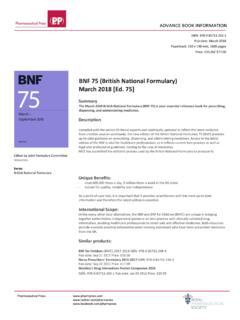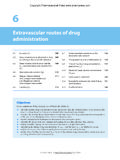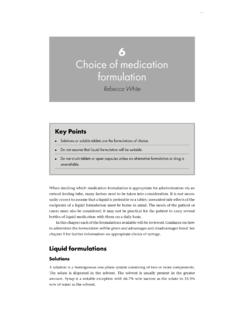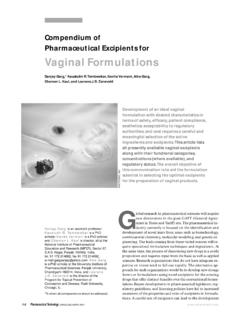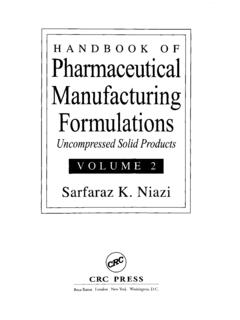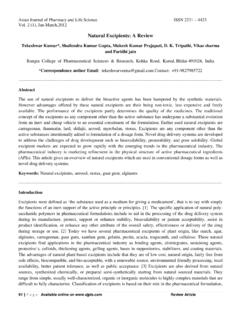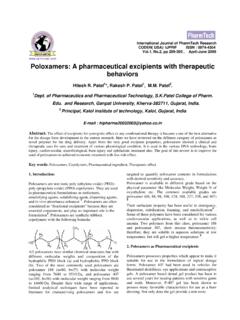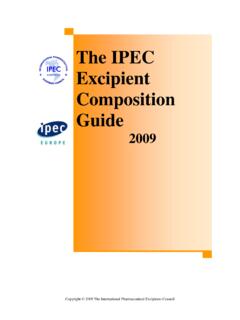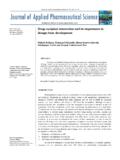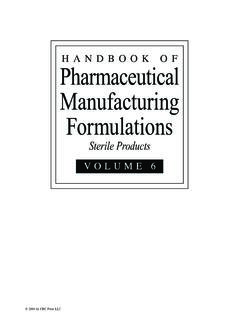Transcription of Cellulose Acetate Phthalate - Welcome to …
1 Sheskey et al., eds. handbook of pharmaceutical excipients , 8th edn. London: pharmaceutical Press, Acetate Phthalate1 Nonproprietary NamesBP: CellacefateJP: CellacefatePhEur: Cellulose Acetate PhthalateUSP NF: Cellacefate2 SynonymsAcetyl phthalyl Cellulose ;Aquacoat CPD; CAP; cellacefate; cellu-lose Acetate benzene-1,2-dicarboxylate; Cellulose Acetate hydrogen1,2-benzenedicarboxylate; Cellulose Acetate hydrogen Phthalate ; Cellulose Acetate monophthalate; Cellulose acetophthalate; celluloseacetylphthalate; cellulosi acetas Chemical Name and CAS Registry NumberCellulose, Acetate , 1,2-benzenedicarboxylate [9004-38-0]4 Empirical Formula and Molecular WeightCellulose Acetate Phthalate is a Cellulose in which some of thehydroxyl groups are acetylated and some are Structural FormulaCellulose Acetate Phthalate is a reaction product of phthalicanhydride and a partial Acetate ester of Cellulose . It of acetyl (C2H3O) groups and of phthalyl(o-carboxybenzoyl, C8H5O3) groups, calculated on the anhydrousacid-free Functional CategoryCoating agent; microencapsulating agent; tablet and capsule Applications in pharmaceutical Formulation orTechnologyCellulose Acetate Phthalate is used as an enteric film-coatingmaterial, as a microencapsulation agent, or as a matrix binder fortablets and capsules.
2 (1 8)Such coatings resist prolonged contactwith the strongly acidic gastric fluid, but dissolve in the mildly acidicor neutral intestinal Acetate Phthalate is commonly applied to solid-dosageforms either by coating from organic or aqueous solvent systems, orby direct compression. Concentrations generally used are the core weight. The addition of plasticizers improves the waterresistance of this coating material, and formulations using suchplasticizers are more effective than when Cellulose Acetate phthalateis used Acetate Phthalate is compatible with many plasticizers,including acetylated monoglyceride; butyl phthalybutyl glycolate;dibutyl tartrate; diethyl Phthalate ; dimethyl Phthalate ; ethylphthalylethyl glycolate; glycerin; propylene glycol; triacetin; triace-tin citrate; and tripropionin. It is also used in combination withother coating agents such as ethyl Cellulose in DescriptionCellulose Acetate Phthalate occurs as a hygroscopic, white to off-white, free-flowing powder, granule, or flake.
3 It is tasteless andodorless, or might have a slight odor of acetic Pharmacopeial SpecificationsThe pharmacopeial specifications for Cellulose Acetate phthalatehave undergone harmonization of many attributes for JP, PhEur,and USP alsoSection I:Pharmacopeial specifications for Cellulose Acetate XVIIPhEur 40 NF 35 S1 Identification Characters(a) Free acid metals(a) 10ppm on ignition ash Viscosity (15% w/vsolution)45 mPa s mPasWater Acetyl (O-carboxybenzoyl) (a) These tests have not been fully harmonized at the time of Typical PropertiesDensity (bulk) (tapped) g/cm3 Melting point1928C. Glass transition temperature is160 1708C.(9)C191 Sheskey et al., eds. handbook of pharmaceutical excipients , 8th edn. London: pharmaceutical Press, contentCellulose Acetate Phthalate is hygroscopic andprecautions are necessary to avoid excessive absorption ofmoisture. Equilibrium moisture content has been reported , but moisture content is a function of relative humidity.
4 (10)See alsoFigure insoluble in water, alcohols, and chlorinatedand nonchlorinated hydrocarbons. Soluble in a number ofketones, esters, ether alcohols, cyclic ethers, and in certainsolvent mixtures. It can be soluble in certain buffered aqueoussolutions as low as pH Cellulose Acetate Phthalate has asolubility of 10% w/w in a wide range of solvents and solventmixtures;seeTable II and Table II:Examples of solvents with which Cellulose Acetate Phthalate has 10%w/w alcoholDioxaneEthoxyethyl acetateEthyl glycol monoacetateEthyl lactateMethoxyethyl acetateb-Methoxyethylene alcoholMethyl acetateMethyl ethyl ketoneTable III:Examples of solvent mixtures with which Cellulose Acetate phthalatehas 10% w/w :ethanol (1:1)Acetone:water (97:3)Benzene:methanol (1:1)Ethyl Acetate :ethanol (1:1)Methylene chloride:ethanol (3:1)SpectroscopyIR spectrumseeFigure spectrumseeFigure spectrumseeFigure (dynamic)A 15% w/w solution in acetone with amoisture content of has a viscosity of 50 90 mPa s(50 90 cP).
5 This is a good coating solution with a honey-likeconsistency, but the viscosity is influenced by the purity of Stability and Storage ConditionsSlow hydrolysis of Cellulose Acetate Phthalate will occur underprolonged adverse conditions such as high temperatures and highhumidity, with a resultant increase in free acid content, viscosity,and odor of acetic acid. However, Cellulose Acetate Phthalate isstable if stored in a well-closed container in a cool, dry 102030405060708090100246810 Relative humidity (%)Equilibrium moisture at 25 C (%)Figure 1:Sorption desorption isotherm of Cellulose Acetate (KM units) 2:Infrared spectrum of Cellulose Acetate Phthalate measured bydiffuse reflectance. Adapted with permission of Informa [2nd deriv. log(1/R)]1100 1300 1500 1700 1900 2100 2300 2500 Wavelength/nm (1/R)11321417164416951888215222312274241 3225321391908167717191661 Figure 3:Near-infrared spectrum of Cellulose Acetate Phthalate measuredby 4:Raman spectrum of Cellulose Acetate Phthalate measured in the1808reflectance mode.
6 Adapted with permission of Informa Acetate PhthalateSheskey et al., eds. handbook of pharmaceutical excipients , 8th edn. London: pharmaceutical Press, IncompatibilitiesCellulose Acetate Phthalate is incompatible with ferrous sulfate,ferric chloride, silver nitrate, sodium citrate, aluminum sulfate,calcium chloride, mercuric chloride, barium nitrate, basic leadacetate, and strong oxidizing agents such as strong alkalis and Method of ManufactureCellulose Acetate Phthalate is produced by a reaction between thepartial Acetate ester of Cellulose and phthalic anhydride in thepresence of a tertiary organic base such as pyridine, or a strong acidsuch as sulfuric SafetyCellulose Acetate Phthalate is widely used in oral pharmaceuticalproducts and is generally regarded as a nontoxic material, free ofadverse effects. However, it may be irritant to the eyes, mucousmembranes, and upper respiratory of long-term feeding in rats and dogs have indicated alow oral toxicity.
7 Rats survived daily feedings of up to 30% in thediet for up to 1 year without showing a depression in growth. Dogsfed 16 g daily in the diet for 1 year remained Handling PrecautionsObserve normal precautions appropriate to the circumstances andquantity of material handled. Cellulose Acetate Phthalate should behandled in a well-ventilated environment; use of a respirator isrecommended when handling large quantities. Eye protection andgloves are Regulatory StatusIncluded in the FDA Inactive Ingredients Database (oral tablets).Included in nonparenteral medicines licensed in the UK. Included inthe Canadian Natural Health Products Ingredients Related SubstancesCellulose Acetate ; hypromellose Phthalate ; polyvinyl Acetate CommentsCellulose Acetate Phthalate has undergone harmonization of manyattributes for JP, PhEur, and USP NF by the PharmacopeialDiscussion Group. For further information see the General in PhEur, along with the State of Work document on the PhEurEDQM website, and also the General Information Chapter G10 inthe plasticizers that are used with Cellulose Acetate Phthalate toimprove performance should be chosen on the basis of experimentalevidence.
8 The same plasticizer used in a different tablet base coatingmay not yield a satisfactory using mixed solvents, it is important to dissolve the celluloseacetate Phthalate in the solvent with the greater dissolving power,and then to add the second solvent. Cellulose Acetate phthalateshould always be added to the solvent, not the Acetate Phthalate films are permeable to certain ionicsubstances, such as potassium iodide and ammonium chloride. Insuch cases, an appropriate sealer subcoat should be reconstituted colloidal dispersion of latex particles rather thansolvent solution coating material of Cellulose Acetate Phthalate isalso available. This white, water-insoluble powder is composed ofsolid or semisolid submicrometer-sized polymer spheres with anaverage particle size of A typical coating system made fromthis latex powder is a 10 30% solid-content aqueous dispersionwith a viscosity in the 50 100 mPa s (50 100 cP) , Cellulose Acetate Phthalate has been reported toexhibit experimental microbicidal activity against sexually trans-mitted disease pathogens, such as the HIV-1 retrovirus.
9 (11,12)19 Specific References1 Spitael J,et al. Dissolution rate of Cellulose Acetate Phthalate andBro nsted catalysis Ind1980;42: 846 Takenaka H,et al. Preparation of enteric-coated microcapsules fortableting by spray-drying technique andin vitrosimulation of drugrelease from the tablet in GI Pharm Sci1980;69: 1388 Takenaka H,et al. Polymorphism of spray-dried microencapsulatedsulfamethoxazole with Cellulose Acetate Phthalate and colloidal silica,montmorillonite, or Pharm Sci1981;70: 1256 Stricker H, Kulke H. [Rate of disintegration and passage of enteric-coated tablets in gastrointestinal tract.]Pharm Ind1981;43: 1018 1021[in German].5 Maharaj I,et al. Simple rapid method for the preparation of enteric-coated Pharm Sci1984;73: 39 Beyger JW, Nairn JG. Some factors affecting the microencapsulation ofpharmaceuticals with Cellulose Acetate Pharm Sci1986;75:573 Chaturvedi K,et al. Cytotoxicity and antitumour activity of 5-fluorouracil-loaded polyhydroxybutyrate and Cellulose Acetate phtha-late blend Microencapsul2013;30(4): 356 Pastor M,et al.
10 Cellulose Acetate Phthalate microparticles containingVibrio cholerae: steps toward an oral cholera Drug Target2014;22(6): 478 Sakellariou P,et al. The thermomechanical properties and glasstransition temperatures of some Cellulose derivatives used in J Pharm1985;27: 267 Callahan JC,et al. Equilibrium moisture content of Dev Ind Pharm1982;8: 355 Neurath AR,et al. Cellulose Acetate Phthalate , a common pharma-ceutical excipient, inactivates HIV-1 and blocks the coreceptor bindingsite on the virus envelope glycoprotein Infect Dis2001;1(1): Neurath AR,et al. Anti-HIV-1 activity of Cellulose Acetate Phthalate :synergy with soluble CD4 and induction of dead-end gp41 Infect Dis2002;2(1): General ReferencesDoelker E. Cellulose Polym Sci1993;107: 199 Directorate for the Quality of Medicines and Healthcare(EDQM). European Pharmacopoeia State Of Work Of ; 23(4): 713 714. (accessed 2 December 2011).Mastropietro DJ, Omidian H. Prevalence and trends of cellulosics inpharmaceutical dosage Dev Ind Pharm2013;39(2): 382 S, Mc Ginity JW.





